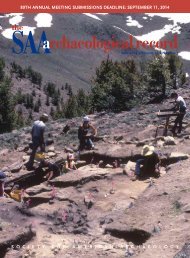SAA
SAA_Record_Nov2015
SAA_Record_Nov2015
You also want an ePaper? Increase the reach of your titles
YUMPU automatically turns print PDFs into web optimized ePapers that Google loves.
NATIVE AMERICAN SCHOLARSHIPS COMMITTEE<br />
A LOOK AT PAST SCHOLARSHIP RECIPIENTS<br />
AND THE NATIVE AMERICAN SCHOLARSHIPS<br />
COMMITTEE<br />
Randy Thompson<br />
Randy Thompson is Agency Superintendent, United States Department of the Interior, Bureau of Indian Affairs Fort Hall Agency.<br />
Randy Thompson prepared this second installment for a series of articles<br />
featuring former recipients of scholarships awarded by the <strong>SAA</strong><br />
Native American Scholarships Committee. Recipient of the Arthur C.<br />
Parker Scholarship in 2000, Randy is now Agency Superintendent for<br />
the Bureau of Indian Affairs Fort Hall Agency. —Tsim Schneider,<br />
Department of Anthropology, University of California, Santa Cruz<br />
I was honored to be the recipient of the Arthur C. Parker Scholarship<br />
in 2000. This scholarship allowed me to attend an archaeological<br />
field school under the direction of Dr. Brooke Arkush,<br />
Weber State University. Attending this field school solidified my<br />
interest in becoming a professional archaeologist (Figure 1).<br />
Under the guidance of several great professors—including Dr.<br />
Arkush, Dr. Richard Holmer (Idaho State University), and Dr.<br />
Patricia Dean (Idaho State University)—and several professional<br />
archaeologists working throughout the Great Basin, I was<br />
able to obtain a Bachelor’s of Arts degree in 2001, and then go<br />
on to receive a Master of Science in Anthropology from Idaho<br />
State University in 2004.<br />
After graduating, I was very fortunate to have been offered a<br />
Student Career Employment Position with the United States<br />
Forest Service. Upon accepting this position I was able to work<br />
in some of the most beautiful places on earth, including the<br />
Caribou-Targhee National Forest where I first worked as an<br />
archaeological technician, and later became a professional<br />
archaeologist. I then spent a few years as the Forest Archaeologist<br />
for the Sawtooth National Forest in Central Idaho before<br />
returning to the Caribou-Targhee National Forest. It was during<br />
my employment with the United States Forest Service that I also<br />
became very involved with tribal relations. As a Shoshone-Bannock<br />
Tribal member, many of the areas where I worked included<br />
places within the traditional homeland of my Tribes. The natural<br />
and cultural resources of these areas continue to be very<br />
important to the Tribes, and I tried to work closely with Tribal<br />
staff to ensure that these resources were protected.<br />
Figure 1. Randy Thompson documenting excavation during field school.<br />
As an archaeologist/cultural resources professional, I was very<br />
fortunate to be able to work with a wide variety of resource professionals<br />
and projects. This interaction allowed me to learn and<br />
grow as a professional and in 2011, I accepted a position with<br />
the Bureau of Indian Affairs Fort Hall Agency, as a natural<br />
resources officer. In July 2014, I accepted the position of Superintendent<br />
of the Fort Hall Agency.<br />
Although I am not currently working as a professional archaeologist,<br />
the experience and knowledge I gained working as an<br />
archaeologist both within and outside cultural resources management<br />
served me well as a professional. I have been very fortunate<br />
in my professional career and I am more than grateful to<br />
have the opportunity to work on my own reservation, assisting<br />
members of my own Tribe in managing reservation trust lands<br />
and resources. The assistance of the Arthur C. Parker Scholarship<br />
was instrumental in this good fortune. I do not know if I<br />
would have ever been able to afford a summer field class without<br />
this assistance.<br />
Looking back, I believe the experience and guidance offered during<br />
this field training is probably the single most important catalyst<br />
that helped solidify my educational and professional goals.<br />
For this opportunity, I would like to thank the Society for American<br />
Archaeology and the Native American Scholarships Committee.<br />
I believe these opportunities can, in fact, change lives.<br />
10 The <strong>SAA</strong> Archaeological Record • November 2015




